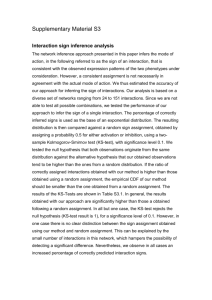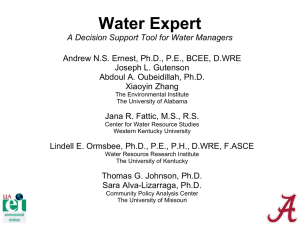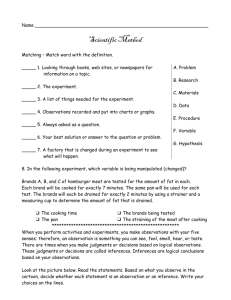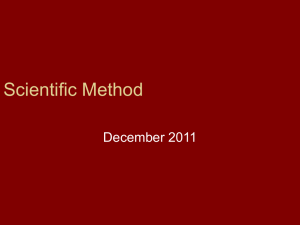SM PPT
advertisement
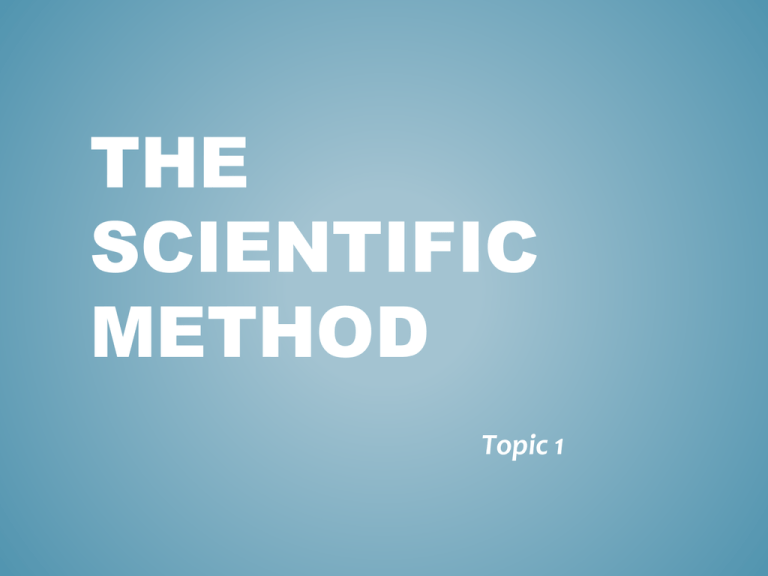
THE SCIENTIFIC METHOD Topic 1 WHAT IS SCIENCE? - a body of knowledge based on observation and experimentation HOW DO WE ACQUIRE KNOWLEDGE ABOUT SCIENCE? We use the SCIENTIFIC METHOD WHAT IS THE SCIENTIFIC METHOD? - a series of steps to be followed when trying to reach a conclusion WHAT ARE THE STEPS? 1. 2. 3. 4. 5. 6. Ask a question Do Research Form a Hypothesis Perform an Experiment Collect and Analyze Data Make a Conclusion 1. ASK A QUESTION - questions usually come from observations you make about your surroundings WHAT’S AN OBSERVATION? - an observation is information gathered using one or many of your senses THE SENSES How many do you have? 5 EXAMPLES OF QUESTIONS/ PROBLEMS… •Why do leaves change color in the fall? •What is a rainbow? •How did the Grand Canyon form? 2. DO RESEARCH You can use • the Internet • Research journals • periodicals 3. FORM A HYPOTHESIS - an educated prediction about the outcome of an experiment HYPOTHESIS… These statements must include… 1. If 2. then ex) If salt crystals are broken into smaller pieces then they will dissolve faster in water. 4. DESIGN AN EXPERIMENT Controlled experiment • only one variable at a time is being changed • Variable- factor that can change or be changed 2 TYPES OF VARIABLES • Independent • Dependent INDEPENDENT VARIABLE variable that is changed by the experimenter “I” change the independent DEPENDENT VARIABLE variable that changes because of the independent variable dependent depends on the independent THE CONTROL the factor in an experiment that represents “normal” conditions and what you compare the experimental data to CONSTANTS Constants are factors that remain the same throughout the experiment 5. COLLECT AND ANALYZE DATA All data must be included, you cannot OMIT anything TYPES OF OBSERVATIONS Objective- just the facts, no opinions are included Subjective- personal opinions are included OBJECTIVE VS SUBJECTIVE YOU DECIDE… 1. 2. 3. 4. objective It’s 78° outside. This room is cold. subjective Erin is short. subjective objective His t-shirt is green. INFERENCE An inference is a conclusion that logically follows a set of observations READ THE FOLLOWING PARAGRAPH AND UNDERLINE THE SENTENCE THAT IS AN INFERENCE IN YOUR NOTES THIS SUMMER HAS BEEN REALLY HOT. I ONLY WATERED MY GARDEN A COUPLE OF TIMES. THE LEAVES OF MY PLANTS ARE DRY AND THE EDGES ARE TURNING YELLOW AND BROWN. I DON’T THINK THEY ARE GOING TO PRODUCE ANY FLOWERS. OBSERVATION VS INFERENCE YOU DECIDE… 1. That cloud is gray. observation 2. It looks like it’s going to rain. inference 3. It looks hot outside. inference TYPES OF GRAPHS • Bar Graph • Line Graph GRAPH SETUP • Give the graph a title • Label and scale the x- axis - Independent variable data • Label and scale the y- axis - Dependent variable data 6. MAKE A CONCLUSION Compare hypothesis to experimental data • Hypothesis accepted • Hypothesis rejected WHAT HAPPENS NOW? Accepted hypothesis • Report results • Peer review Rejected hypothesis • Start over

